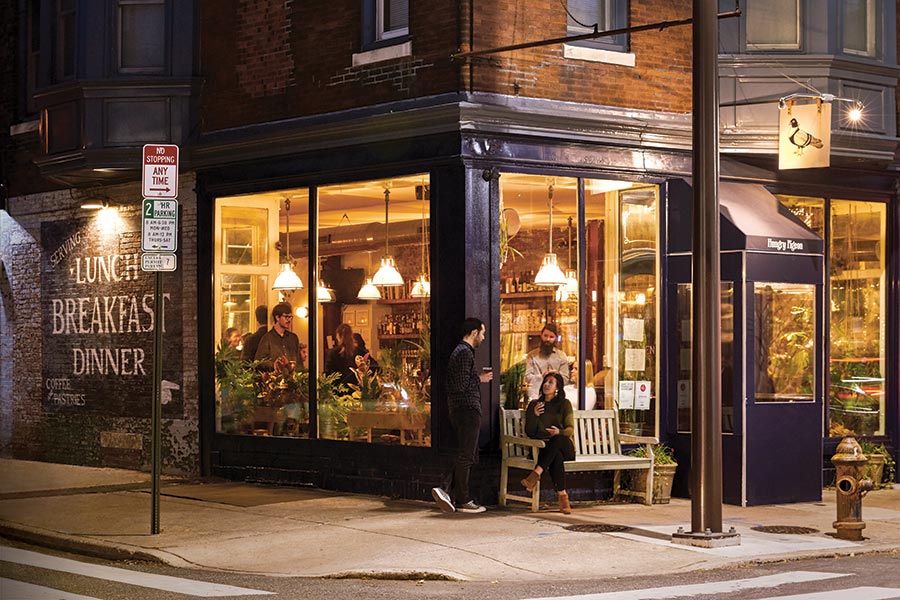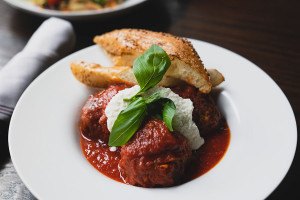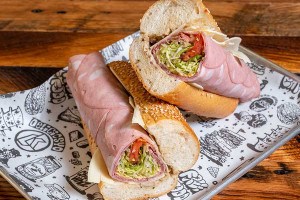Philly’s Third Restaurant Renaissance Has Arrived
Starr, Vetri, Garces, Solomonov. The founding fathers of our restaurant revival have either cashed out, moved on or lost their mojo. Where does that leave Philly? Maybe with our best food yet.

Hungry Pigeon | Photograph by Jason Varney
Food writers in Philadelphia go through what I like to call the “12 Steps of Stephen Starr.” Okay, there are more like four steps, but my point is that it’s a wearisome process with an enlightening ending. It goes something like this. Step one: Believe Stephen Starr is a corporate suit whose restaurants are predictable and annoyingly unavoidable. Step two: Learn that places like Continental, El Vez and Morimoto changed entire neighborhoods. That is something, you think. Step three: Realize how many impactful chefs (Jose Garces, Michael Schulson) came from his kitchens. Step four … you see where this is going, right? Eventually, the anti-establishment, Jonathan Gold-worshipping ideological foodies (myself included) all find themselves appreciating Stephen Starr for what he did for Philadelphia.
I reached the final step when I left my job as food editor at this magazine to work for him. (I found my way back to Philly Mag a few years later.) Experiencing the breadth of Starr Restaurants firsthand was transformative. But my biggest takeaway was this: Stephen Starr believed that Philadelphia was a place that could have nice things. And so he gave them to us.
That emotional hump he dragged us over set into motion a monumental chain of events. Garces opened Amada in 2005 and brought us tapas. Marc Vetri went big with Osteria in 2007 and brought us real pizza. Michael Solomonov and Zahav and out-of-the-oven pitas came in 2008. Barbuzzo, Village Whiskey, Pizzeria Stella … there were more. Georges Perrier and Steve Poses were the godfathers of Philly’s original restaurant awakening in the 1970s, but by 2010, the second renaissance had reached fever pitch. It was the culinary equivalent of an arms race, in which every restaurant was more novel and delicious than the last one. We weren’t as flashy as New York, as rebellious as L.A. or as inventive as San Francisco, but we were suddenly worthy of attention. People around the country started mentioning Philly chefs — our chefs! — by name. We finally had something, although we weren’t quite sure what it was.
In 2007, the year that Osteria opened, this magazine ran an essay by then-food editor April White titled “Fork in the Road.” The article was well-timed. White believed that our food scene was at a tipping point and wondered what it would become. Did the land of water ice and BYOs and Stephen Starr have the strength and confidence to grow into a world-renowned food city? The years after proved that we certainly had the ambition.
And then, around 2010, something changed. The big openings from the big guys began to feel … expected. Some restaurants were just flat-out head-scratchers. Places like JG Domestic, Alla Spina and Juniper Commons added volume, but not ingenuity. There were bright spots, but Philly’s food scene was in a rut comprised entirely of small plates. Even the menu designs became indistinguishable. The owners must have felt it, too. Whether they lost their way, lost their money or just simply moved on, our restaurant kingpins began to ghost.
But the void they left didn’t stay empty long. When most of us weren’t looking, a new group of chefs — with their own way of doing things — quietly, subtly and unexpectedly ushered in Philly’s third restaurant renaissance. And with it, we just may have finally found our true culinary identity.
» PHOTOS: Philly’s New Food Establishment
Scott Schroeder has a really loud laugh. It’s lovable — just like his sense of humor and denim overalls — and it carries across the room. In theory, none of that jibes with what you think of when you think of Philly’s coolest restaurant. But Hungry Pigeon, on a sleepy corner in Queen Village, is a true reflection of co-owner Schroeder and his baker-extraordinaire partner, Pat O’Malley, so it totally fits. As I post up at the poured concrete bar on a Monday night in October, I hear that laugh above the people streaming in, above the server talking up the wine, above everything else.
Tonight, Hungry Pigeon is hosting “Pizza Camp — No Pizza,” a pop-up dinner with Joe Beddia, of wait-in-line-to-get-one-of-40-pizzas-made-nightly Pizzeria Beddia. (Schroeder and Beddia are longtime buddies and new brothers-in-law.) Bon Appetit named Beddia’s pies the best in America in 2015, and he has a cookbook out, so this event is kind of a big deal. I arrive at 5 p.m. and wait on a bench on 4th Street with a few other groups until the doors open. By 5:15, the place is packed. In true Hungry Pigeon fashion, this special dinner is put on rather unceremoniously. There’s no prix-fixe meal, no reservations and the event was announced only 12 days before on Instagram. My options for food are three different hoagies, a tomato pie (note: not pizza), a Caesar salad, and a lasagna topped with a Caesar salad. That’s it. The most expensive thing on the menu is that lasagna, which is $12. The bread was made in-house to Beddia’s specifications. The veggie hoagie is impossibly flavorful and tender for a sandwich that’s mostly eggplant and broccoli. The trio next to me — a young guy flanked by his parents — push a plate over my way. Their hoagie is so good, they insist I take a bite.
Beddia and Schroeder stand a few paces back from the door, like dignitaries at the end of a receiving line but with the warmth of two brothers who own an Italian BYO in South Philly. The scene feels like it’s from a different time, some weird blend of old Philly and new Philly. The Hungry Pigeon has exceptional food, but it also has soul.
How can a place that feels like a coffee shop and has vegan breakfast bowls and a handful of things for dinner keep me coming back? Keep people lined up outside? Be packed on a Monday night?
Really, Schroeder, 42, spent his career building up to this moment. The Detroit native worked his way through Philly kitchens starting in his 20s. He kept moving on and up, seeking more skills, more practice. There were stints at Brasserie Perrier, Pasión, Jake’s in Manayunk. He worked with Nick Elmi here, Joey Baldino there, met O’Malley along the way. He eventually landed the head-chef gig at South Philly Tap Room in 2003. “It was the first time anyone just sort of, like, saw what I was doing and wanted me to do it,” says Schroeder. His food and big personality — and the beer — lured people to Point Breeze. But 12 years was enough. “It honestly felt like, ‘What am I supposed to do now?’” he says. “Am I really going to run someone else’s restaurant? What’s the difference? And I’m not really structured enough for a hotel job or a prestigious chef job. This was, I felt, the only thing I’d be comfortable with in life — to for real do what I think a restaurant should do.”
After spending all those years cooking for other people, Schroeder knew — like so many of the chefs, bakers, cooks and owners who make up this new wave — that there was finally an intersection between the kind of place he’d like to own and the kinds of places this new era of Philadelphia eaters would like spend time in.
Schroeder’s restaurant picks up where those look-at-me, high-concept Center City spots that opened in the aughts left off. The menu changes daily. The food is pedestrian in concept — lasagna, braised chicken, pasta, brussels sprouts — but while each dish is something we all love to eat, it’s done in a way that’s just so much better. The breads and pastries are Paris-good, and Schroeder’s laugh is the restaurant’s soundtrack. If you want to find the je ne sais quoi of Philadelphia’s new food scene, go to Hungry Pigeon.
Well, you also might want to check out ITV, Cheu Noodle Bar, Helm, Palizzi Social Club, Vernick, Friday Saturday Sunday, Stock, Laurel, Will, Philly Style Bagels, Essen Bakery, Stargazy, Royal Izakaya … Like start-ups that come out of an incubator, these eateries grew out of the scene that Starr, Vetri, Garces, Solomonov et al. created. That group gave us the whole package — they taught Philadelphia diners that even hummus could be otherworldly, convinced us to trust the experience, and made us believe there’s no reason to ever have a bad meal in Philadelphia again. They had the ambition to make Philly a city with a legit food scene. But they always felt like our guys with their places. These new chefs? They feel like our guys with our places.
“Isn’t this just what Europe has?” Schroeder asks one November afternoon, as we discuss how varied Philly’s food scene has become — how the most unassuming corner spot that only serves soup could be worth driving across town for. “It’s almost like Philadelphia embraced its [own] food. I worked in Brasserie Perrier when Vetri opened, and it was this whole thing. Like, ‘What the hell is that? A little restaurant? And they are doing this? There aren’t just monster 300-seat restaurants?’”
Now, Philadelphians will come out on a Monday night at 5 p.m. to Queen Village to eat a veggie hoagie. This new generation of chefs knows that smaller spots, in random locations, serving super-niche, concept-less or almost nonsensical food, will be adored. (Essen is a modern version of a Jewish bakery. Res Ipsa is a coffee shop that turns into a high-end Italian eatery at night. Royal Boucherie has foie gras on special in an Old City bar.) They’re a far cry from the perfect, moneyed, GM-laden big-deal eateries that have dominated the past decade, but these are the places that now ooze with excitement — the kinds of places that can’t be replicated. It suddenly seems like every bite in Philly is really, really good. “I don’t think we are trying to subscribe to a food trend,” says Schroeder. “We are trying to be a restaurant like restaurants used to be. We aren’t reinventing anything. You are supposed to come here and not be impressed by how creative it was. You are supposed to say, ‘Man, that was a really good lasagna.’”
When i eat in other cities now — New York, L.A., London — I can’t help but take pleasure in my apathy. With the exception of a few meals, the food isn’t any better than what I can get at my neighborhood cafe. This means we no longer have to judge ourselves by what we aren’t. “Philadelphians are way more discerning than New Yorkers,” Marc Vetri says one morning at his Spruce Street flagship. “Just because you opened in New York doesn’t mean anything.”
While some of these next-gen chefs have trained in New York, it’s heartening to see how many of them are Philly through and through. Up-and-coming chefs no longer need the Jean-Georges or Danny Meyer restaurant on a CV to be taken seriously — now you can get that training par excellence here. “It used to be, ‘Oh, this guy is coming here and he’s from New York and we have to be as good as New York,’” says Schroeder. “Now, it’s totally the opposite: ‘Oh, you’re from New York? Are you any good?’”
This confidence and swagger are at the crux of what this third-wave restaurant renaissance is. When you no longer need to compete, you have the self-assurance to do a slapdash reopen of a private club in a rowhome with killer Italian food, like Joey Baldino did with Palizzi Social Club, or put a high-end sushi counter in the back of a grungy neighborhood bar, like Royal Izakaya. I took my out-of-town brother to Royal Izakaya on his last visit, and he declared, “This is so Philly!” (And he wasn’t talking about a cheesesteak.)
Will the authenticity last? Tough to say. In many ways, it’s harder than ever to operate a restaurant in Philadelphia. Margins are increasingly slim; regulations and taxes and labor drive up costs. “The landscape is different, but it’s the same,” says Vetri. “It’s still going to be super-hard to make it with the chef-owner restaurant.” The truth is, 1998 Marc Vetri didn’t want more than a small place on Spruce Street. Eight years in, he had accomplished so much: national recognition, a demand for reservations, a restaurant that was a true reflection of himself. What did he have to show for it? Five thousand dollars in the bank: “I looked at my new wife and said, ‘What the fuck am I going to do? How are we going to have kids? I have to open another restaurant.’”
So the real question just might be, can these rebellious chefs expand — because they’re all eventually going to need to make more money — while holding onto the magic that makes their places so special now? “We do plan on expanding, but we don’t plan on it being a restaurant,” says Schroeder. “This is an excellent flagship. I hope to sit here for 25 years.” He gets offers and explores all the possibilities. Maybe a wine bar in Center City? O’Malley wants a bakery.
Really, I don’t think it matters. Even if Nick Elmi and Greg Vernick become the next Solomonovs and Vetris — and it seems they’re headed that way — they’ve altered our scene forever. “You know your city has arrived when it’s well-rounded — when you’re taking everything seriously from the beginning to the end, from the cocktails to the desserts,” Dana Cowin, the former editor of Food & Wine, told this magazine for that 2007 essay. Yeah, we’ve finally got all of that now, plus bagels that are better than New York’s. But who’s counting?
» Click for Philly’s 50 Best Restaurants
Published as “Philly’s Third Restaurant Renaissance” in the January 2018 issue of Philadelphia magazine.


